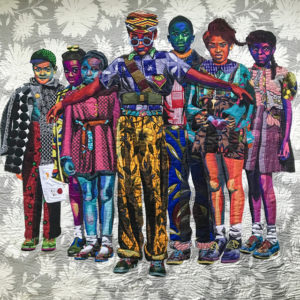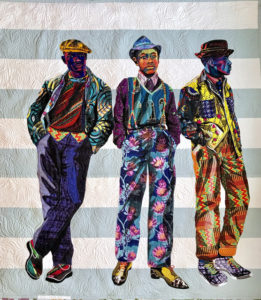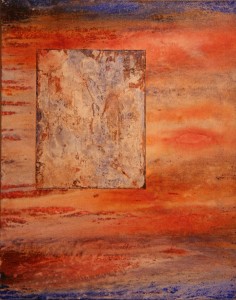Dear Artist,
In his 1946 essay “Why I Write,” English novelist George Orwell identified four reasons: political purpose, historical impulse, sheer egoism and aesthetic enthusiasm. For example, Orwell believed that no book was genuinely free from political bias and that writing was one of the most powerful tools to push the world in a certain direction. “The opinion that art should have nothing to do with politics,” he wrote, “is itself a political attitude.”

The Safety Patrol, 2018
Quilted and appliquéd cotton, wool and chiffon
82 × 90 inches
by Bisa Butler (b. 1973)
As for historical impulse, Orwell explained that writing could be an attempt to place one’s ideas into context and, as a young Helen Frankenthaler discovered upon seeing the paintings of Peter Paul Rubens for the first time, to “convey the sense of being alive at a certain time.” To Frankenthaler, gasping at the knock-out paintings of another should propel you to aspire to make your own worthy of some same, future, admiration — what she called a “thrilling feeling,” or a “charge.”
For egoism, Orwell expounded on the “desire to seem clever, to be talked about, to be remembered after death, to get your own back on grown-ups who snubbed you in childhood, etc.” From what he described as his lower-upper-middle-class upbringing and gentleman-class heritage, Orwell insisted that most writers shared a unique ambition with a minority of humanity — those who remained, after the age of 30, determined “to live their own lives to the end,” by controlling their destiny and agency with creative work.
Lastly, and perhaps the most agreed-upon reason amongst good writers, was Orwell’s motive of aesthetic enthusiasm. He called it the “pleasure in the impact of one sound on another, in the firmness of good prose or the rhythm of a good story.” When applied to painting, these motives can, at least for me, feel revealingly true. That artists continue, for example, to emulate their artist heroes with lifestyle and behavioral myths and style tropes no longer relevant nor romantic in 2021, illustrates just how powerful the notions of egoism and historical impulse continue to be. In re-creating the scenes of our artistic fantasies, we hope to create something representative of artmaking in our own time. The quest for originality then has to muddle through these unnecessary and obstacle-creating regurgitations. “Who controls the past controls the future,” wrote Orwell. “Who controls the present controls the past.”
Sincerely,
Sara
PS: “Every generation imagines itself to be more intelligent than the one that went before it, and wiser than the one that comes after it.” (George Orwell)
Esoterica: In her 2013 manifesto on womanhood and writing, “Things I Don’t Want To Know”, British novelist, playwright and poet Deborah Levy riffs on Orwell’s ideas, but from a contemporary perspective. For example, Levy caveats ego-force with the proviso that women, in order to write in the first place, must re-animate that which has all but been squashed for the purposes of domestic labour and child-rearing. “Perhaps,” she wrote, “when Orwell described sheer egoism as a necessary quality for a writer, he was not thinking about the sheer egoism of a female writer. Even the most arrogant female writer has to work over time to build an ego that is robust enough to get her through January, never mind all the way to December.”
And up until recently, it’s felt at times, as though political purpose and aesthetic enthusiasm in painting have fallen into a church and state divide, with social commentary in visual art bumbling around in a kind of de-skilled or jarringly mechanical or even hostile aesthetic. Imagine for a moment, if historically, writers of biting social criticism and polemical essays also, and in order to do so, abandoned elegant wordsmithing. A re-joining of these two creative impulses has now, perhaps, sparked a renaissance of beauty and craftsmanship. In doing so, it shall hopefully advance our social progress.
Have you considered a Premium Artist Listing? With each letter, an artist is featured at the bottom of this page. The Premium Artist Listings are a means of connecting artist subscribers through their work. Proceeds from each listing contribute to the production of The Painter’s Keys.
“No woman is really an insider in the institutions fathered by masculine consciousness.” (Adrienne Rich)
Featured Artist
Painting is my passion and joy. My process is intuitive, though informed by good composition and design principles. I paint what I remember, or think about, or feel, or just what comes off my hands to the brush to the canvas. Texture and color are of primary importance to me. I typically choose my support, texture it, select my palette, and go. There is nothing more satisfying to me than watching paint run and move. I love the surprises. I experiment and learn constantly. It is a remarkable journey. One I am pleased to share with you.








10 Comments
This one’s right up there with your dad’s best, Sara. Profound and stimulating in every sense.
I agree wholeheartedly, Sara! It’s about time someone held all art to some standard of excellence. It’s not enough to be ONLY making a sociopolitical statement or ‘expressing yourself’–good art requires some skill and attention to the classic principles of design etc. The art by Bisa Butler you have chosen to illustrate your letter today is an excellent example of art that is both excellent for its own sake, and full of social commentary. As both an artist and a writer, I grow impatient with art and books that fail to communicate, that ignore any application of the standards of excellence, and then excuse themselves by calling it ‘self-expression’–if no-one can decode your message without an accompanying lecture, and if your work is poorly executed to boot–well, what exactly are you expressing about yourself, and how do you imagine your message is being received? By all means paint or write just to please yourself, with no goal in mind–but then please don’t display your art or publish your writings or claim that somehow you’ve achieved some grand purpose. Art critics please note–sometimes art is just poorly done, no matter how much the artist is today’s hot news ticket.
“Imagine for a moment, if historically, writers of biting social criticism and polemical essays also, and in order to do so, abandoned elegant wordsmithing” YES, exactly! Thank you.
Yes, there just isn’t the same impact.
I love your comment at how “political purpose and aesthetic enthusiasm in painting have fallen into a church and state divide”. One is as ridiculous as the other. I endeavour to meld all four concepts in my work. They contain a political statement, albeit subtle, amid the aesthetic ambitions toward beauty and the infusion of spiritual meditations. Often I get comments about how peaceful or joyful my work is. It leaves me wondering if they have really looked at it.
Beautiful choice of art to accompany this powerful and timely message. Thank you!
Thank you for the introduction to the wonderful work of Bisa Butler, who “paints” with fabric.
Good one, Sara! Thank you.
In a way I don’t understand, the use of fabric, in patterns, just for color, becomes more believable than collage. They are the same approach, but perhaps the stitching adds so much. The stitching is like drawing, especially in Bisa Butler’s work, where the drawing in the fabric cuts are amplified by the threads that hold it together. Good work, Sara.
Thank you for the letter and the amazing art by Bisa Butler-Aesthetic beauty, sensitivity and workmanship and much more! Social progress is possible with the aid of art like this. Absolutely wonderful!
Beauty and craftsmanship never go out of style.